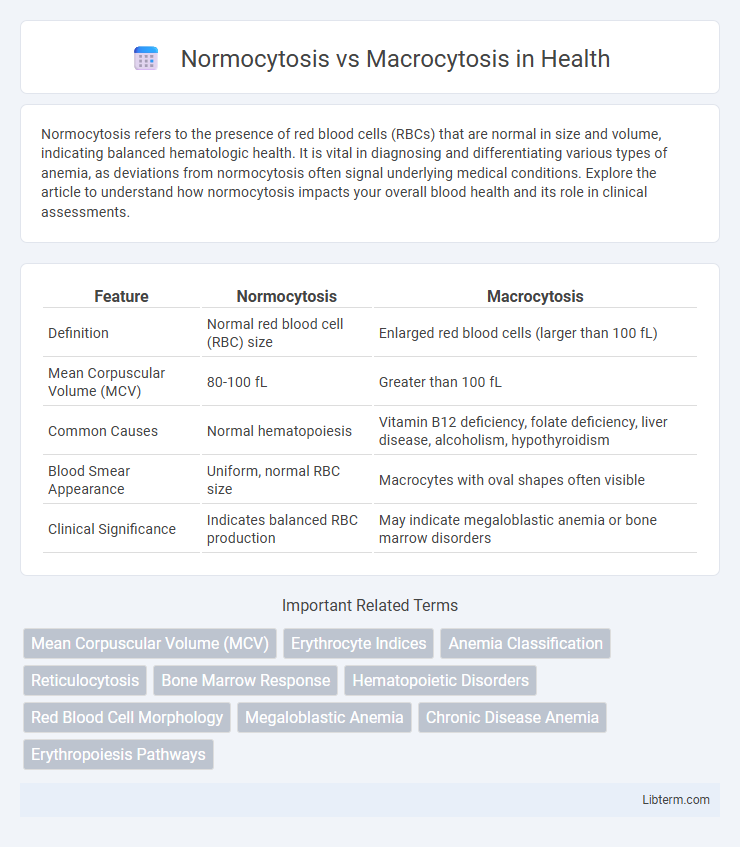Normocytosis refers to the presence of red blood cells (RBCs) that are normal in size and volume, indicating balanced hematologic health. It is vital in diagnosing and differentiating various types of anemia, as deviations from normocytosis often signal underlying medical conditions. Explore the article to understand how normocytosis impacts your overall blood health and its role in clinical assessments.
Table of Comparison
| Feature | Normocytosis | Macrocytosis |
|---|---|---|
| Definition | Normal red blood cell (RBC) size | Enlarged red blood cells (larger than 100 fL) |
| Mean Corpuscular Volume (MCV) | 80-100 fL | Greater than 100 fL |
| Common Causes | Normal hematopoiesis | Vitamin B12 deficiency, folate deficiency, liver disease, alcoholism, hypothyroidism |
| Blood Smear Appearance | Uniform, normal RBC size | Macrocytes with oval shapes often visible |
| Clinical Significance | Indicates balanced RBC production | May indicate megaloblastic anemia or bone marrow disorders |
Introduction to Red Blood Cell Morphology
Normocytosis refers to the presence of red blood cells (RBCs) with normal size and volume, typically measured by mean corpuscular volume (MCV) ranging from 80 to 100 femtoliters. Macrocytosis indicates larger-than-normal RBCs, with an elevated MCV above 100 femtoliters, often signaling impaired DNA synthesis or vitamin B12/folate deficiency. Understanding RBC morphology through blood smear examination and MCV values is essential for distinguishing between normocytosis and macrocytosis, aiding in the diagnosis of underlying hematologic conditions.
Defining Normocytosis: Normal Cell Size Explained
Normocytosis refers to the presence of red blood cells (RBCs) within the normal size range, typically measured by mean corpuscular volume (MCV) between 80 and 100 femtoliters. In contrast, macrocytosis indicates enlarged red blood cells with an MCV exceeding 100 femtoliters, often associated with conditions like vitamin B12 deficiency or liver disease. Understanding normocytosis is crucial for diagnosing anemia and differentiating it from macrocytic anemias, ensuring precise clinical assessment and treatment.
Understanding Macrocytosis: Enlarged Red Blood Cells
Macrocytosis is characterized by enlarged red blood cells with a mean corpuscular volume (MCV) exceeding 100 femtoliters, in contrast to normocytosis where MCV ranges between 80-100 fL. This condition often indicates underlying issues such as vitamin B12 or folate deficiencies, liver disease, or bone marrow disorders, making it crucial for targeted diagnostic evaluation. Monitoring macrocytosis through complete blood count (CBC) and peripheral smear analysis aids in identifying hematological abnormalities and guiding effective treatment strategies.
Key Differences between Normocytosis and Macrocytosis
Normocytosis refers to the presence of red blood cells with a normal mean corpuscular volume (MCV) typically between 80-100 fL, indicating healthy erythrocyte size and function. Macrocytosis is characterized by an increased MCV greater than 100 fL, often associated with conditions such as vitamin B12 deficiency, folate deficiency, or liver disease. Key differences include red blood cell size, underlying causes, and diagnostic implications for assessing anemia types and guiding appropriate treatment strategies.
Common Causes of Normocytosis
Normocytosis, characterized by normal-sized red blood cells, often occurs in conditions such as acute blood loss, hemolytic anemia, and anemia of chronic disease. These causes maintain red blood cell size within normal ranges despite varying pathologies. In contrast, macrocytosis involves enlarged red blood cells commonly due to vitamin B12 deficiency, folate deficiency, or liver disease.
Etiologies Behind Macrocytosis
Macrocytosis is primarily caused by deficiencies in vitamin B12 or folate, leading to impaired DNA synthesis and enlarged red blood cells. Other etiologies include liver disease, hypothyroidism, alcoholism, and certain medications like hydroxyurea and methotrexate. In contrast, normocytosis presents with normal red blood cell size and typically indicates conditions such as acute blood loss or chronic disease anemia without alteration in cell volume.
Clinical Implications and Symptoms
Normocytosis indicates red blood cells of normal size, typically reflecting healthy erythropoiesis, while macrocytosis involves enlarged red blood cells often associated with vitamin B12 or folate deficiency, liver disease, or bone marrow disorders. Clinically, normocytosis generally suggests stable oxygen delivery without hematologic abnormalities, whereas macrocytosis can present with symptoms including fatigue, pallor, glossitis, and neurological deficits due to underlying anemia or marrow dysfunction. Accurate differentiation through complete blood count (CBC) and peripheral smear is crucial for diagnosing conditions like megaloblastic anemia or myelodysplastic syndromes, guiding targeted treatment strategies.
Diagnostic Approaches and Laboratory Assessment
Normocytosis is characterized by red blood cells (RBCs) with normal mean corpuscular volume (MCV) ranging from 80-100 fL, while macrocytosis presents with elevated MCV above 100 fL. Diagnostic approaches for normocytosis often involve evaluating reticulocyte count and peripheral blood smear to identify underlying causes like anemia or chronic disease, whereas macrocytosis assessment requires additional tests including vitamin B12 and folate levels, liver function tests, and bone marrow examination for possible megaloblastic changes or myelodysplastic syndromes. Laboratory assessment relies on complete blood count (CBC) parameters, RBC indices, and specialized assays to differentiate the etiologies, guiding targeted treatment strategies.
Treatment Strategies for Macrocytosis
Treatment strategies for macrocytosis primarily target the underlying causes such as vitamin B12 or folate deficiencies, requiring supplementation therapy to restore normal red blood cell size. Monitoring and managing conditions like liver disease, hypothyroidism, or bone marrow disorders is essential to prevent progression, often involving tailored pharmacologic and supportive interventions. Regular blood count assessments and addressing medication-induced macrocytosis optimize patient outcomes and reduce hematologic complications.
Prognosis and Prevention Tips
Normocytosis indicates normal red blood cell size, generally associated with a favorable prognosis and minimal complications, while macrocytosis, characterized by enlarged red blood cells, often signals underlying conditions such as vitamin B12 deficiency or liver disease, potentially leading to anemia or neurological issues. Early diagnosis of macrocytosis improves prognosis by enabling targeted treatments like vitamin supplementation or addressing alcohol use. Preventive measures include maintaining a balanced diet rich in essential vitamins, avoiding excessive alcohol consumption, and regular blood tests to monitor red blood cell indices for early detection.
Normocytosis Infographic

 libterm.com
libterm.com